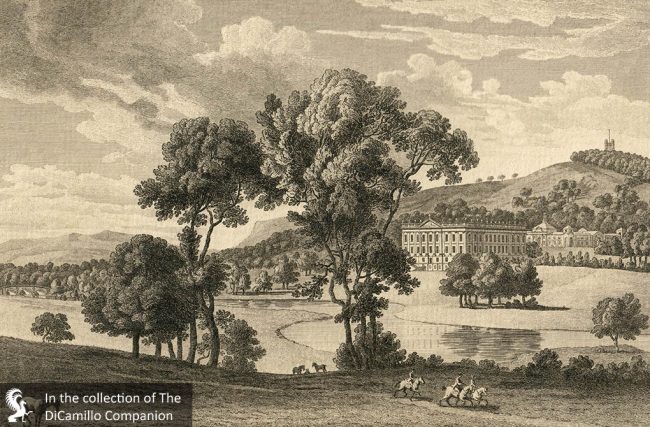
A 1778 engraving of the house from "The Copper Plate Magazine." Behind the house are Paine's stables, above which (to the right) is the Hunting Tower.

The house from "Morris's Views of Seats," circa 1875.

The north wing and the west facade from a circa 1950s Johnson Brothers soup bowl from the Old Britain Castles in 1792 series

The west facade from a circa 1896 postcard
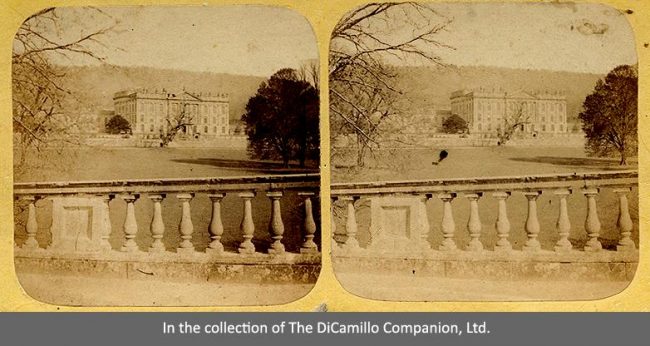
The west facade from a 19th century stereoscope photo
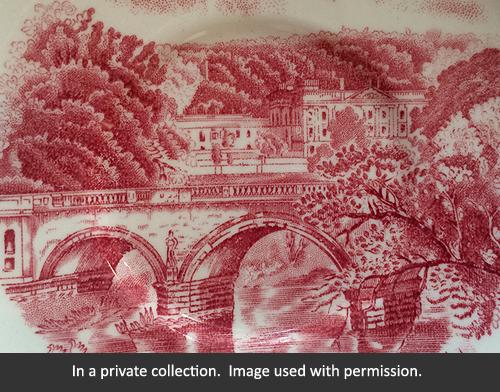
The west facade from a circa 1950s Johnson Brothers large teacup saucer from the Old Britain Castles in 1792 series
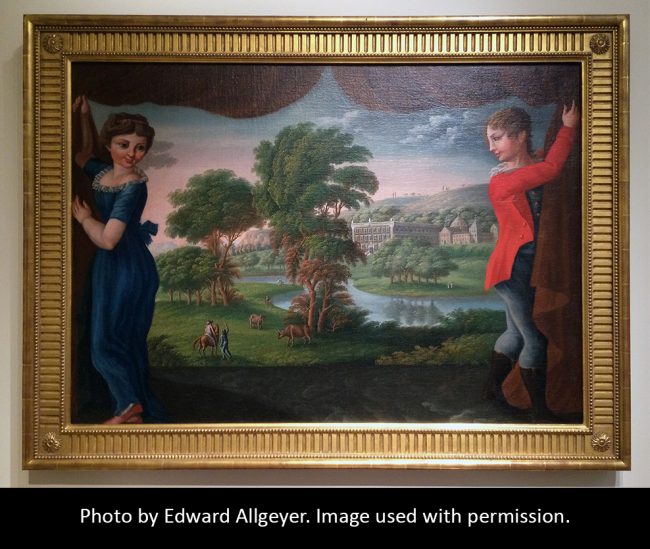
Chatsworth by Michele Felice Corné, circa 1800, in the collection of the Peabody Essex Museum, Salem.

The west facade from a circa 1909 postcard

Chateau de Marly, near Paris, from a 19th century print. Chatsworth's west facade was probably inspired by the chateau, which was demolished circa 1806.

The south facade
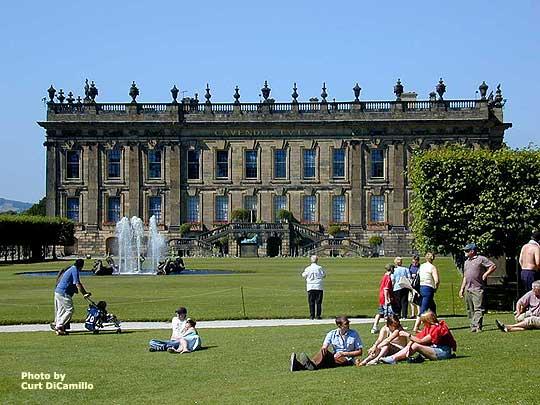
The south facade
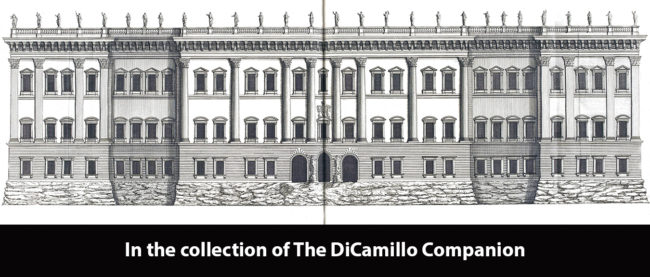
Bernini's unexecuted 1665 plan for the east facade of the Louvre, Paris. It's been suggested that the south facade of Chatsworth was inspired by Bernini's design.
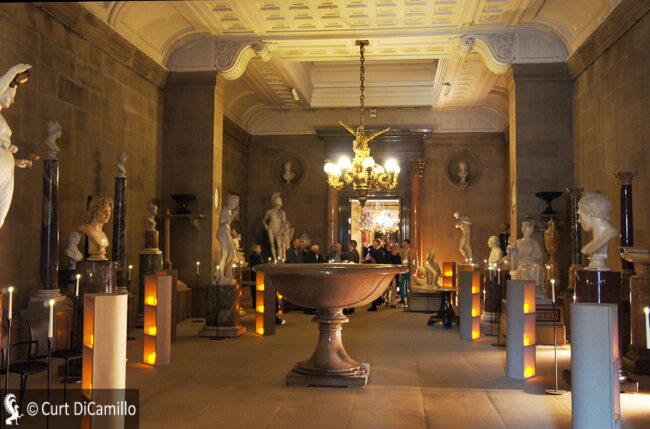
The Sculpture Gallery

The Music Room from a circa 1921 postcard
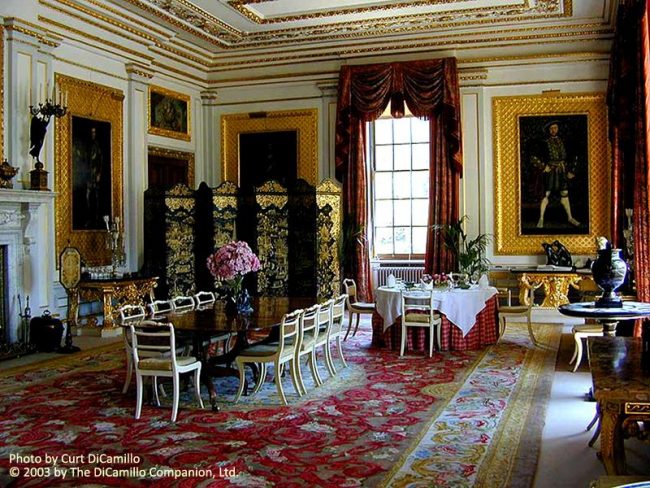
The Private Dining Room
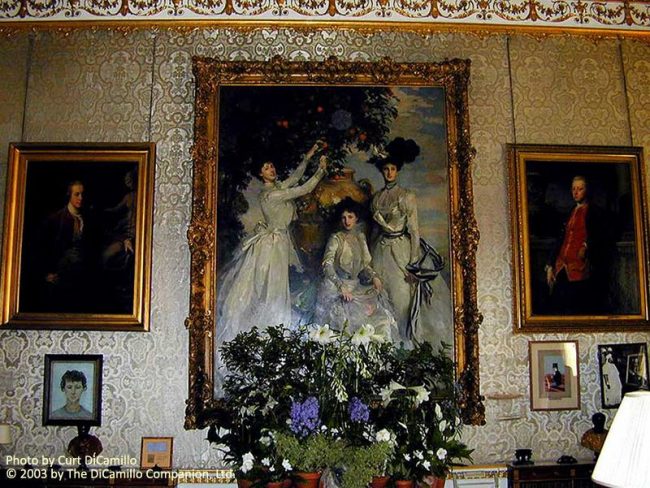
The Blue Drawing Room

The coronation throne of William IV
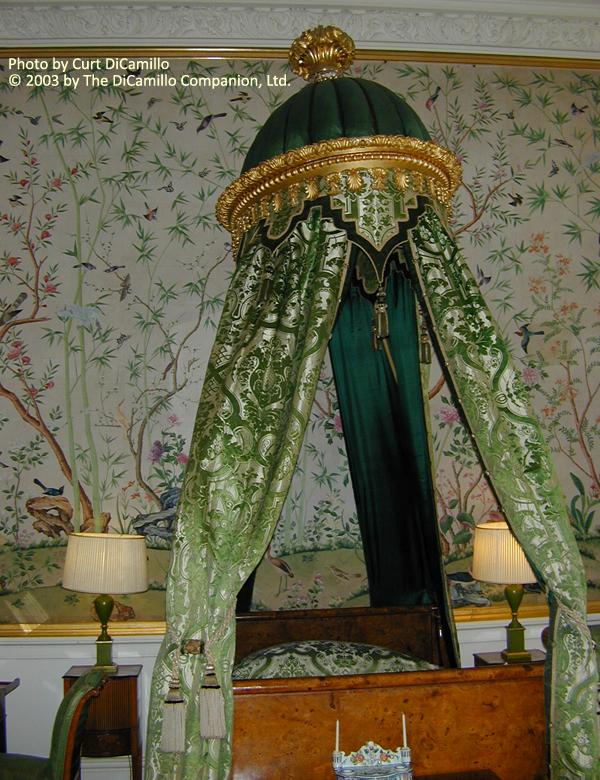
The Duke of Wellington's Bedroom

The Red Velvet Bedroom

The silver chandelier
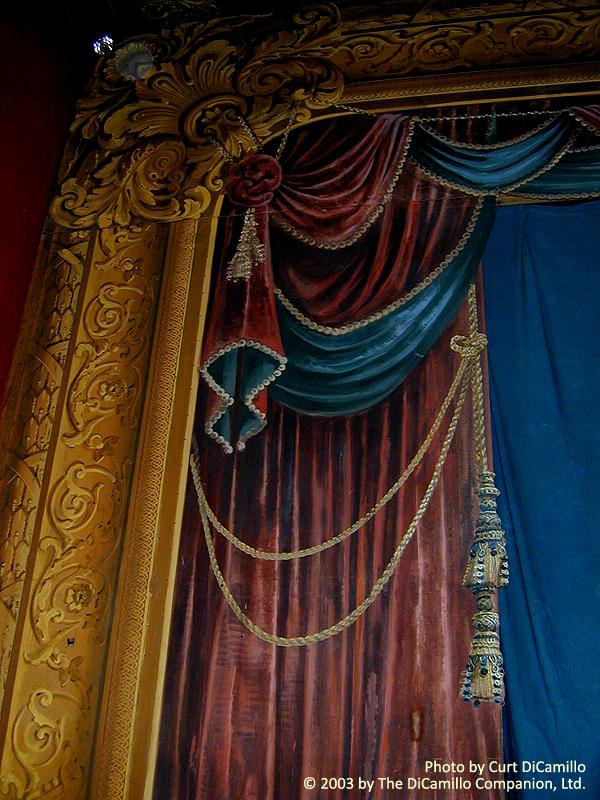
Painted curtain in the theatre

James Paine's stables
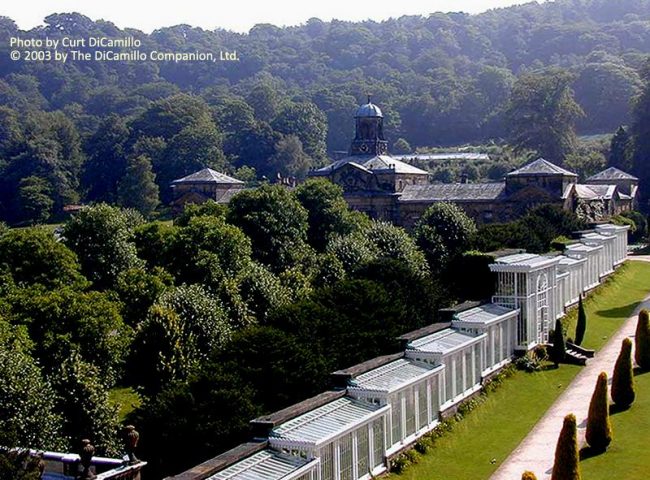
The Conservatory Wall with the stables in the background

The Seahorse and Emperor Fountains
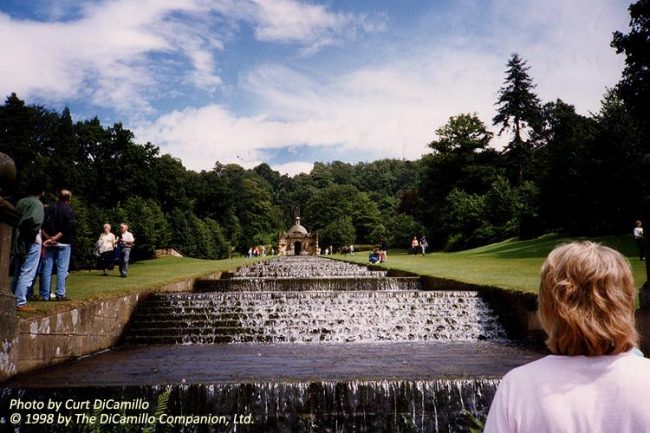
The cascade from the bottom
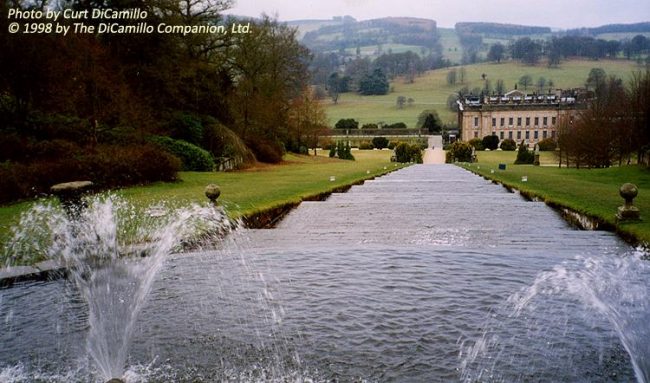
The cascade from the top

The Cascade House
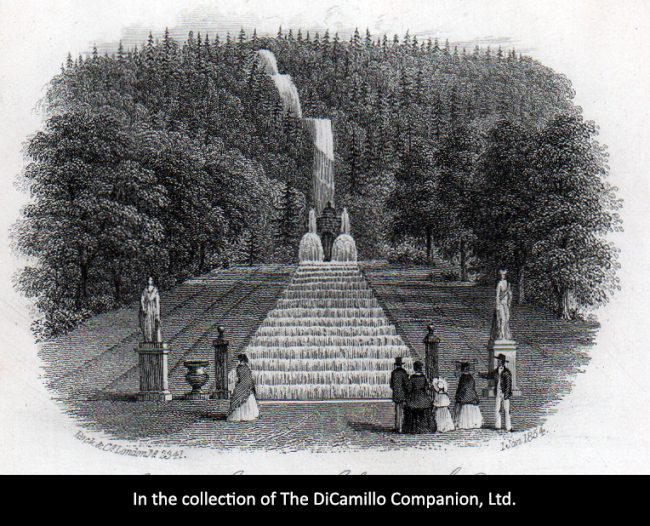
The cascade from an 1854 engraving
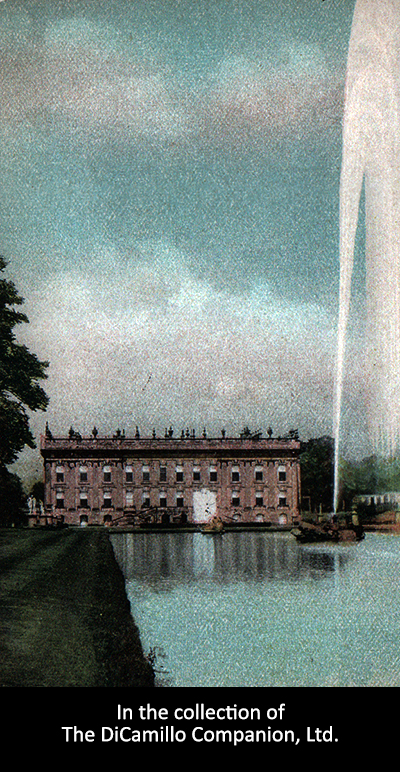
The Emperor Foundation playing at 260 feet from a 1906 postcard
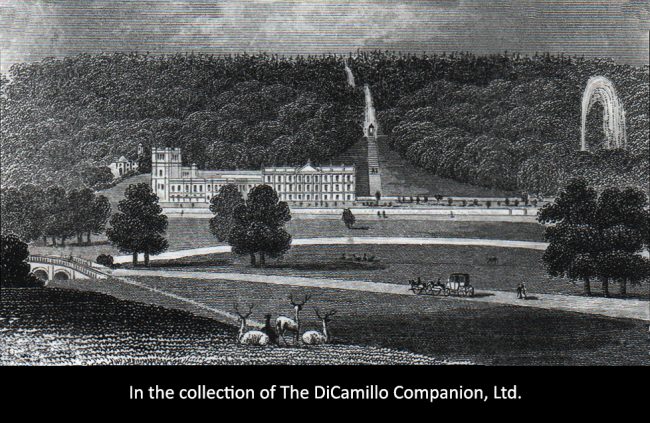
The house, cascade, and Emperor Fountain from an 1854 engraving.
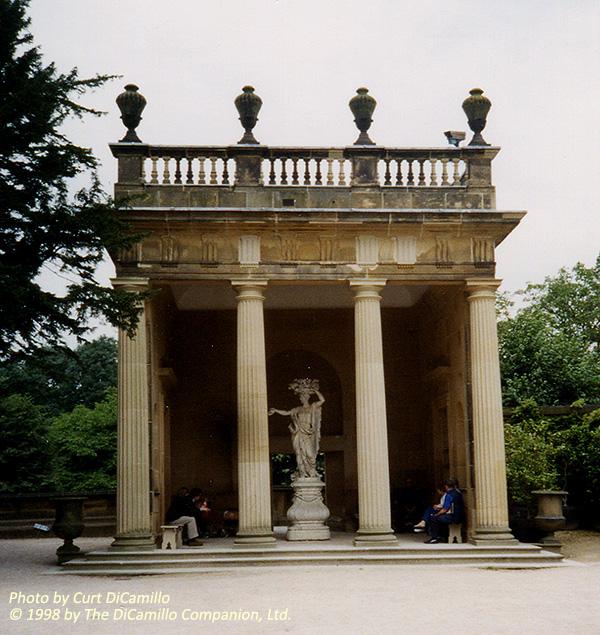
Flora's Temple
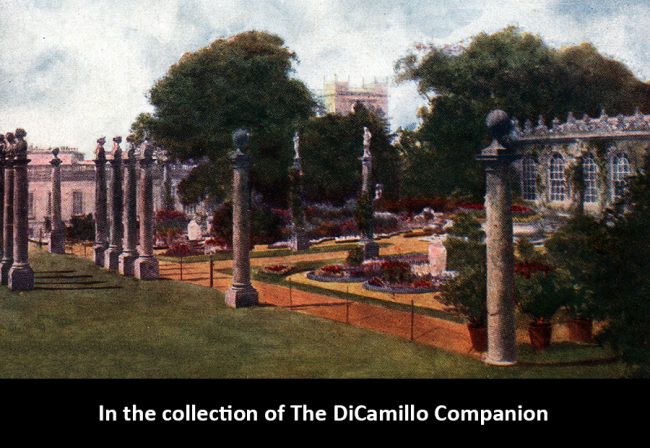
The Rose Gardens from a circa 1902 postcard
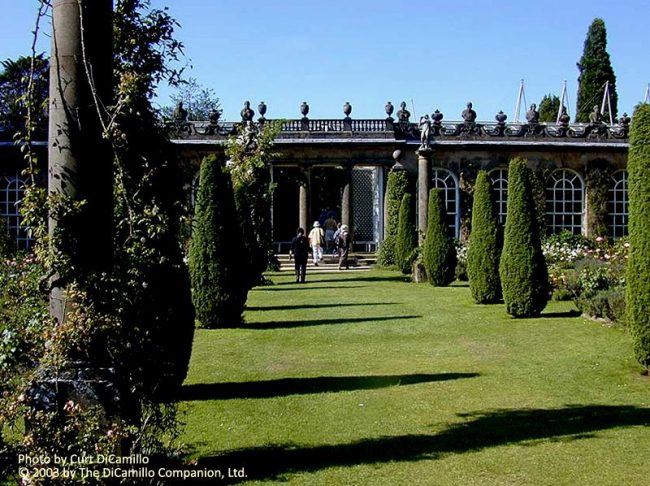
The Rose Gardens in 2013
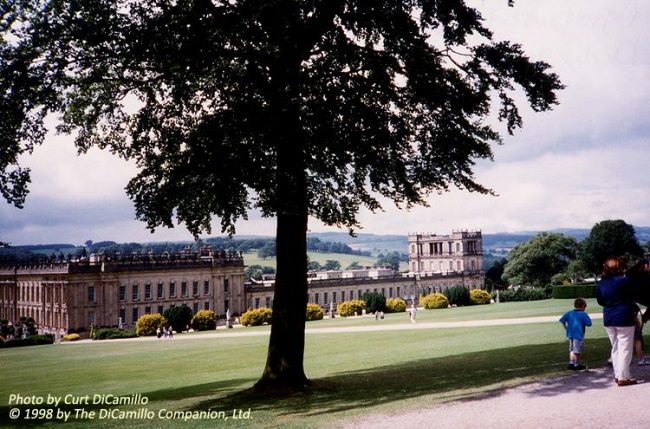
The Salisbury Lawns
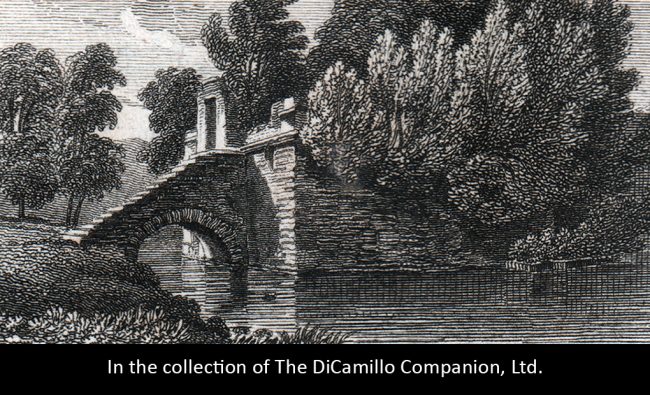
Queen Mary's Bower from "Peacock's Polite Repository," 1829.
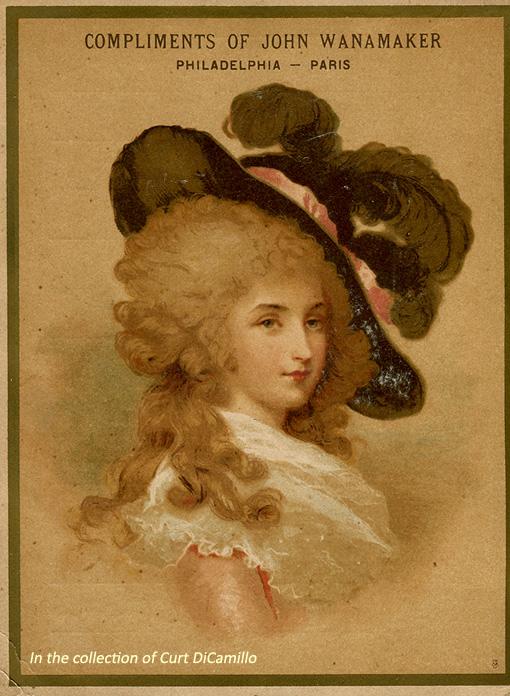
Early 20th century promotional card from Philadelphia department store Wanamaker's with an adapted version of Gainsborough's portrait of Georgiana, Duchess of Devonshire.

Reproduction of Gainsborough's famous 1787 portrait of Georgiana, Duchess of Devonshire, on 19th century porcelain at The Breakers, Newport, Rhode Island.

An 1863 chromolithograph print of the Devonshire Gems from Masterpieces of Industrial Art & Sculpture, at the International Exhibition, 1862.

The circa 1850 Chatsworth alabaster peep egg
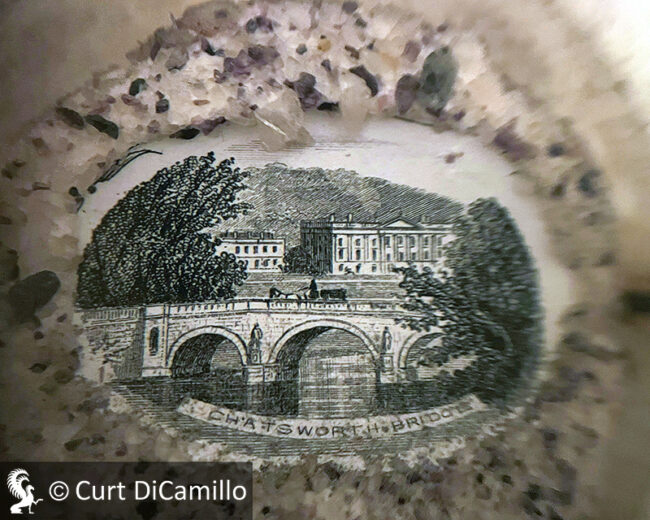
Woodcut view of Chatsworth, surrounded by Derbyshire minerals, from the circa 1850 Chatsworth alabaster peep egg.

Crystals, stones, and dried plants from the circa 1850 Chatsworth alabaster peep egg
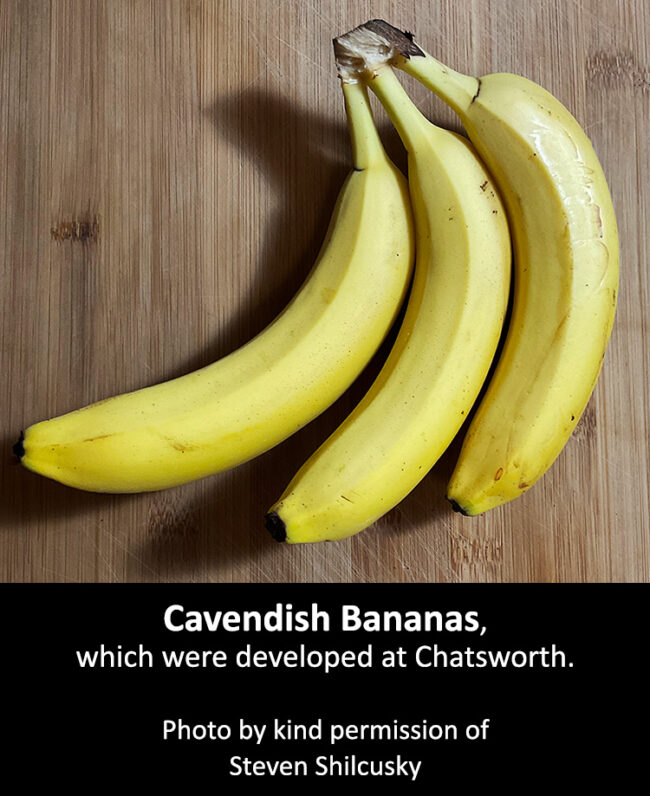

An 1854 photograph of the Crystal Palace, London. This famous building (the first world's fair) was based on the demolished Great Conservatory at Chatsworth.
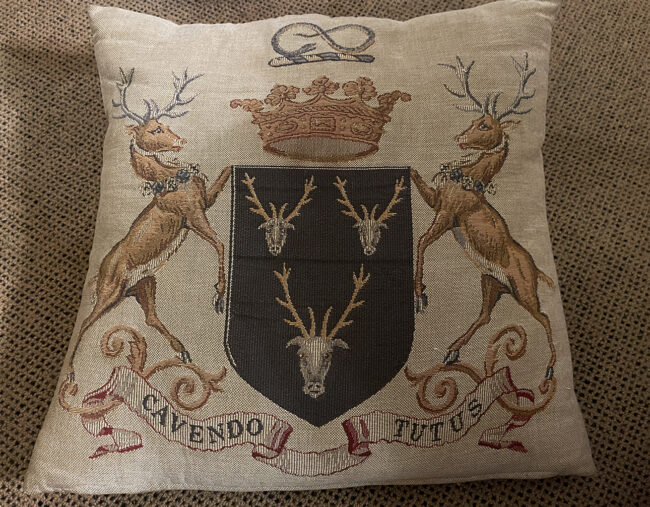
Pillow with the arms of the dukes of Devonshire. Made on the Chatsworth Estate. the pillow is stuffed with feathers from Chatsworth geese. In a private collection. Image used with permission.
House & Family History: Sir William Cavendish came from Cavendish in Suffolk. He grew rich as one of Henry VIII's commissioners for the Dissolution of the Monasteries. When Sir William married Bess of Hardwick in 1547, she convinced him to move to her native Derbyshire, where, in 1552, they began building a courtyard house enclosed by four wings—the foundation of today's Chatsworth. Their second son, William, was created 1st Earl of Devonshire in 1618 by virtue of his payment of £10,000 to the crown. Mary, Queen of Scots, was a prisoner at Chatsworth, off-and-on, between 1569 and 1584. The 1st Duke took Bess's house and, using William Talman as his architect, transformed Chatsworth. Very much of what is seen today is the result of the 1st Duke's alterations and additions, which took place between 1687 and 1707. There is even speculation that the 1st Duke may have designed part of the house himself, particularly after his falling out with Talman. The 2nd Duke was the grandfather of Henry Cavendish (1731-1810), the scientist who determined the composition of water, recognized hydrogen as an element, and was the first man to "weigh the world." Henry's library of 12,000 books today resides at Chatsworth. The 4th Duke married the only surviving child and heiress (Lady Charlotte Boyle) of the 3rd Earl of Burlington. Lady Charlotte brought large estates to the Cavendish family: Lismore Castle in Co. Waterford, Londesborough Hall in Yorkshire, and Chiswick House and Burlington House in London. Bolton Abbey in Yorkshire came to the family through a marriage with the Clifford family. The Frenchman Guillaume Gaubert was employed in the 1780s to design interiors at Chatsworth; by 1783 he was working for the Prince Regent at Carlton House. The 6th Duke of Devonshire employed Jeffry Wyatville to extend the house, creating the 360-foot-long north wing, which replaced James Paine's earlier north wing. This new 19th century wing included the theatre (directly beneath the tower), the sculpture gallery, and a library, in addition to a new suite of state rooms (Wyatville also altered the private apartments). The theatre is one of the rarest surviving private theatres of the late 19th century. The room was originally built in the 1830s as the 6th Duke's banqueting room; it was redone as a theater for the 8th Duke in 1896 by the famous scenery designer and maker William Hemsley, who supplied sets, stage equipment, and a painted proscenium. The ceiling has four ceiling panels by Louis Cheron that lined the library, until the Bachelor Duke filled the walls with bookshelves; the paintings are still in their early 18th century Samuel Watson frames. The ceiling also contains landscape panels of 1690 by Sir James Thornhill. For much of the 20th century the theatre was used for other purposes, most recently serving as the textile conservation studio for Chatsworth. Beginning in 2006 the theatre was opened to the public, with theatrical productions once more taking place in this magical space. In 1857 the 6th Duke supported the Manchester Art Treasures Exhibition, the first public show of the treasures of English country houses. The 9th Duke was the first to have to pay death duties; this forced major sales from the Chatsworth collections (see "Collections" field). The eldest son of the 10th Duke, the Marquess of Hartington, married Kathleen Kennedy, sister of President Kennedy, in 1944. The marquess was killed, four months after his marriage, in action in Belgium, and Kathleen died in an airplane crash in 1948. Much of the furniture that William Kent designed for Devonshire House in Piccadilly was brought to Chatsworth after Devonshire House was demolished in 1924. Chatsworth includes painted ceilings by Verrio, Thornhill, and Laguerre. The Painted Hall contains a particularly fine Laguerre, painted 1692-94, showing scenes from the life of Julius Caesar. The State Dining Room has gilt side tables that were designed for Lord Burlington, father-in-law of the 4th Duke, by William Kent. The State Drawing Room tapestries were woven circa 1635 at Mortlake and are cartoons of biblical scenes after Raphael. The State Music Room contains the famous trompe l'oeil painting of a violin on a door by Jan van der Vaart. The door, complete with painting, was removed from Devonshire House in London. Also in the State Music Room are two gilded chairs that were used by George III and Queen Charlotte after their coronation in 1761. Tsar Nicholas I of Russia gave the green malachite table, urns, and clock to the 6th Duke, who was a friend. The State Bedroom contains the bed of George II, who died in it in 1760. George V and Queen Mary slept in this bedroom in 1933 when they visited Derbyshire. The ceiling of the west stairs was painted by Sir James Thornhill and depicts "The Fall of Phaeton" (one of his earliest paintings). The Oak Room has paneling and carved heads from a German monastery, bought by the 6th Duke. The chandelier over the Oak Stairs contains stag horns (a gift from William IV to the 6th Duke) from the park at Windsor Castle. The Great Dining Room served its first meal in 1832, when it hosted a dinner party for Princess Victoria (later Queen Victoria) and her mother, the Duchess of Kent. During World War II the house was occupied by Penrhos College, a girls' school; 300 students and teachers lived and worked at Chatsworth from 1939 until 1946. Today Chatsworth is the nexus of an estate of 35,000 acres (55 square miles), which includes farms, rivers, villages, quarries, woods, and moorland, and employs over 140 people (including electricians, drivers, security staff, seamstresses, a mason, plumbers, and painters). The house has a roof that covers 1.3 acres, contains 175 rooms, 17 staircases, 359 doors, and over 3,400 feet of passageways. Chatsworth staff are famous for their loyalty and longevity; by 1997 there had been 197 staff that had served for 25 years and 102 for 40 years. There is a painting in the collection of the Peabody Essex Museum, Salem, Massachusetts, of Chatsworth by the Italian painter Michele Corne, who worked north of Boston in the late 18th/early 19th century. Chatsworth is frequently cited as Jane Austen's model for Pemberley in "Pride and Prejudice."
Collections: The jewel in the crown of the collections at Chatsworth is the collection of Old Master drawings, one of the most important in the world, including works by Raphael, Titian, Dürer, Rembrandt, and Rubens. There are also Old Master paintings by Rembrandt, Hals, van Dyck, Tintoretto, and Veronese, with significant pieces by Landseer and Sargent. Chatsworth's sculpture gallery contains the best collection of Neoclassical sculpture in England, with pieces by Cibber and Canova, among others. In 1839 the 6th Duke of Devonshire purchased an enormous ancient marble foot in Rome that had formerly been in the collection of the Guinigi family's palazzo at Lucca. Created 150-50 BC, the foot was probably part of a colossal statue of a seated Greek god or goddess that may have stood 36 feet tall. There is a similar right foot at the Pergamon Museum in Berlin that is believed to match the left foot at Chatsworth. The library is the most important country house library in existence; it contains over 17,000 volumes, including the most complete collection of botanical books in Britain and architectural drawings by Palladio and Inigo Jones. In 1912 the 9th Duke, to raise money to pay death duties, was forced to sell all the Caxtons in the library, the John Kemble collection of plays, and many first editions of Shakespeare, all of which went to the Huntington Library in California. There is also a rare early English silver chandelier, one of the few surviving pieces of silver furniture in the UK, probably made in 1694 to celebrate the creation of the dukedom (see photo of the chandelier in the "Images" section). The Chatsworth collection also contains the Flemish boxwood rosary made for Henry VIII and Katharine of Aragon, circa 1509-27. The 23-inch-long rosary was purchased by the 6th Duke; each bead is carved with figures and scenes from the Bible. The famous Devonshire Gems, also called the Devonshire Parure, was made for the 6th Duke's sister, Lady Granville, to wear at the 1856 coronation of Tsar Alexander II in Moscow. The parure is considered the most important surviving example of English jewelry of the Romantic period and is set with 88 classical gems from the Devonshire Collection (see chromolithograph of the Devonshire Gems in the "Images" section). The collection at Chatsworth also contains one of the most magnificent ancient gems in existence: "Diomedes Stealing the Palladion" by Dioskourides, court engraver to the Emperor Augustus. This amazing carnelian gem once belonged to Louis XIV and was purchased by the 2nd Duke of Devonshire in 1726 from Sevin in Paris. The collecting of antique gems in Britain reached such an intense and competitive level in the 18th century that the French gem expert P.J. Mariette, writing in "Traité des Pierres Gravées" in the 1750s, said "nowhere is more love shown for classical gems" [than in England]. Chatsworth today contains the largest private collection of engraved gems in the world. Chatsworth also contains the porcelain dinner service of Warren Hastings, governor general of India, made in Berlin, circa 1780. Hastings was forced to sell much of the contents of his house (Daylesford), including this service, to pay legal bills resulting from his trial for corruption (he was acquitted). His neighbor, the 1st Baron Redesdale, purchased the service and it descended in the family until it became the property of the 11th Duchess's father. The 6th Duke purchased the gasoliers in the Sculpture Gallery (see photo in "Images" section) and a very large carved table at the 1822 auction of the contents of Wanstead House in Essex. Upon the death of the 10th Duke, nine of the most important works of art at Chatsworth, in addition to the Hardwick Hall Estate, were given to the treasury in lieu of death duties. Nicolas Poussin's "Holy Family" was sold at Christie's on April 10, 1981, for £1,650,000. The piece was a shared purchase by the Norton Simon Museum, Pasadena, California, and the Getty Museum. Seventy-one Old Master drawings from a collection formed by 2nd Duke were sold at Christie's on July 3, 1984, for a total price of £21,179,880. The pieces consisted of Rembrandt Hermenszoon van Rijn's "View of the Amstel" for £668,160; Sir Peter Paul Rubens's "Man Threshing Beside a Wagon," sold to the Getty Museum for £779,520; Raphael's "St. Paul Rending His Garments," sold to the Getty Museum for £1,512,000; Rembrandt's "Two Thatched Cottages with Figures at Window," sold to Mrs. Christian Aall of New York for £349,440; Rembrandt's "The Bulwark De Rose and the Windmill De Smeerpot," sold to Squire Bozorth of New York for £522,640; Rembrandt's "A Sailing Boat" was sold to H. Schickman Gallery of New York for £458,640; Rembrandt's "A Farmstead by a Stream" was sold to George Abrams of Boston, Massachusetts, for £393,120; Sir Anthony van Dyck's "Study for the Entombment" was sold to the H. Schickman Gallery of New York for £262,080; Rubens's "Three Groups of Apostles for the Last Supper" was sold to the Getty Museum for £604,800; Raphael's "Study of a Man's Head and Hand" was sold to Fine Art Mutual of New York for £3,603,600; Giorgio Vasari's page from the Libro de' Disegni was sold to I. Woodner of New York for £3,276,000; Titian's "Landscape with a Nude and Sleeping Shepherds" was sold to Etablissement DC, Monte Carlo, for £414,960; Rembrandt's "View of Houtewaal" was sold to J.R. Gaines of Kentucky for £436,800; Hans Holbein's "Portrait of a Scholar" was sold to the Getty Museum for £1,612,400; Andrea Mantegna's "Saints Peter, Paul, John the Evangelist and Zeno" was sold to the Getty Museum for £1,223,200; Rembrandt's "A Wooded Road" was sold to the H. Schickman Gallery, New York, for £371,280; van Dyck's "A Wooded Landscape" was sold to the H. Schickman Gallery, New York, for £262,080; Raphael's "Mercury Offering the Cup of Immortality to Psyche" was sold to the Staatliche Graphische Sammlung, Munich, Germany, for £131,040; Romano's "Vineleaf Design for a Bowl" was sold for £172,800; Parmigianino's "The Virgin Nursing the Child" sold for £167,400; Giovanni Antonio Licinio da Pordenone's "Allegory of Time" sold for £388,800; Federico Barocci's "Entombment, with the Ducal Palace, Urbino, Behind" sold for £388,800; Sir Anthony van Dyck's "Hendrick van Balen" sold for £583,200; Jacques Callot's "Louis, Prince de Phalsbourg, on Horseback" sold for £124,200. The following pieces were sold at Christie's on December 5, 1985: Andrea Mantegna's "Bacchanal with a Wine Press," a copperplate engraving dated 1520, was sold to David Tunick of New York for £366,667; Rembrandt's "Christ Presented to the People" sold for £561,600; Giovanni Benedetto Castiglione's "Creation of Adam" sold for £345,600; Albrecht Dürer's "Vision of St. Eustace" sold for £205,200. The following pieces were sold at on July 6, 1987 at Christie's: Veronese's "Martyrdom of St. Justina" sold to the Getty Museum for £623,250; Giovanni Antonio da Pordenone's "Martyrdom of St. Peter" sold to the Getty Museum for £567,500; Rembrandt's "The Ramparts near the Bulwark Beside the St. Anthoniespoort" sold to Ms. V. Cavalieri of New York for £1,426,250; Federico Barocci's "Madonna del Popolo" sold to D. Tunick of New York for £1,784,000; Rembrandt's "A Farmhouse with Dovecote and Hayrick Among Trees" was sold to P.W.K. Russell of Amsterdam for £557,500; Raphael's" Figure Study of a Kneeling Woman" was sold to the National Gallery of Scotland for £449,800. In 1994 the Chatsworth Estate purchased, for £265,000, the famous 1785-87 Gainsborough portrait of Georgiana, Duchess of Devonshire, that was commissioned by her husband, the 5th Duke (see "Images" section). The canvas left Chatsworth in the 1830s under strange circumstances, during which time it was cut down. It was sold to an art dealer in 1841 and was then auctioned by Christie’s in 1876 for £10,000 (approximately £6 million in 2022 values), which made it the most valuable painting in the world at the time. The buyer was the London dealer Thomas Agnew & Sons, who sold it to Junius Morgan, who purchased the painting as a gift for his son, J.P. Morgan. On May 26, 1876, before Morgan took possession, the portrait was stolen from Agnews. In 1901, 25 years later, the thief sold the painting back to Agnews, who sold it to J.P. Morgan for £30,000. The famous painting remained in the Morgan family until 1994, when it was put up for auction at Sotheby’s and purchased by the 11th Duke of Devonshire. In 2010 two small enameled white china jars with vermeil mounts in the collection at Burghley House were identified as being possibly the earliest hard-paste porcelain manufactured in Europe, pre-dating that produced at Meissen by at least 25 years (until the discovery of these jars it had been accepted that the first true hard-paste porcelain in Europe was manufactured in 1708 in Saxony; the Burghley jars are made of true hard-paste porcelain from a formula that is significantly different of that found in Asian porcelain). The jars are listed in the 1683 Devonshire Schedule of Deed, where they are referenced as "Buckingham China" and specifically called "A pair of little Jarrs and Covers guilt and Enamel'd with ffestoones and Boyes heads." The Devonshire Schedule of Deed listed valuable pieces that came to Burghley from Chatsworth after the death of Lady Elizabeth Cavendish, mother of Anne, wife of the 5th Earl of Exeter. In June 2010 the bronze relief "Ugolino Imprisoned with his Sons and Grandsons" (circa 1549) by Leonardo's nephew, Pierino da Vinci, was sold privately for £10 million to the Prince of Liechtenstein for his museum in Vienna. Between October 5 and 7, 2010 the Chatsworth Attic Sale was held by Sotheby's in a marquee on the estate, raising £5.3 million (excluding buyer's premium) in 1,416 lots; the two most expensive items were George II carved white marble chimneypieces designed by William Kent circa 1735 for the saloon (£565,250, lot 82) and the ballroom (£457,250, lot 109) at Devonshire House, London. In addition to those pieces acquired by Lord Elgin, The British Museum's collection of sculptures from the Parthenon includes fragments from Chatsworth and Colne Park, Colne Engaine, which have no connection with Lord Elgin. There have been a number of exhibitions in the United States that showcased art from Chatsworth, including the 1979-80 "Treasures from Chatsworth: The Devonshire Inheritance," 2003's "The Devonshire Inheritances: Five Centuries of Collecting at Chatsworth," and "Treasures from Chatsworth: The Exhibition," which was mounted by Sotheby's in 2019.
Comments: John Harris, writing in "William Talman: Maverick Architect," states that Talman's work at Chatsworth resulted in a look never before seen in English architecture. Clive Aslet writes in "Landmarks of Britain: The Five Hundred Places That Made Our History" that Chatsworth was the first Baroque palace built in England for a subject, rather than a monarch; Aslet goes on to say that Chatsworth is "now considered the most consummate example of a great English country house" and that it "occupies its position as the country house that all other country houses aspire to be like..."
Garden & Outbuildings: Thomas Archer is attributed with creating the cascade temple (from which the water flows), circa 1702; the engineering of the cascade itself was done by a Frenchman. The 200-meter cascade (over 650 feet), the Willow Tree Fountain, and the canal all remain from the 1st Duke's formal garden. Originally called the Bowling Green House, Flora’s Temple was built between 1693 and 1695 and contains a statue of Flora by Caius Gabriel Cibber; the temple was moved from the Bowling Green to its current site near the house in 1750. Capability Brown landscaped the park in the 1760s. Brown's work was all-encompassing and even involved changing the course of the River Derwent. James Paine built the bridge over the river and the stables. The world’s most commercially exploited banana, the Cavendish, came from Chatsworth. This banana, which accounts for 99% of bananas exported to developed countries, was named in honor of William Cavendish, the 6th Duke of Devonshire, who acquired an early specimen, which he raised in Chatsworth’s Great Conservatory. Sadly, the Cavendish banana may be coming to the end of its existence; the cultivar is vulnerable to Panama disease, a devastating fungal disease that the parthenocarpic fruit is poorly equipped to fight. A successful replacement for the Cavendish will depend on the future of genetic engineering. The Great Conservatory, designed for the 6th Duke by Joseph Paxton (whom the duke appointed as head gardener in 1826), was built between 1836 and 1841. When it was completed, the conservatory was the largest greenhouse in the world: 277 feet long, 123 feet wide, and 61 feet high, complete with a carriage drive that ran the length of the building. It cost the enormous sum of £33,099 (approximately £29 million in 2020 inflation adjusted values) and was celebrated for its exotic plants, brought to Chatsworth from expeditions to the Far East and the Americas. The conservatory was so admired that it was the model for the Crystal Palace in London (the first world’s fair), designed by Paxton for the Great Exhibition of 1851. Sadly, the massive greenhouse was demolished after World War I, when there was neither the money nor the manpower to maintain it. In 1962 the Chatsworth maze was planted with 1,209 yews in the center of the site of the former Great Conservatory (two flower gardens occupy the rest of the site). Joseph Paxton also designed the Emperor Fountain, which shoots an amazing 296 feet into the Derbyshire sky. Gravity-fed, it was the highest fountain in the world in 1843, when it was installed and named in honor of Tsar Nicholas I of Russia (the fountain also generates electricity for the house). The private West Garden is a footprint, in box hedges, of the architectural plan of Chiswick House, once one of the London-area houses of the dukes of Devonshire. The inspiration for the garden, like so much else at Chatsworth, came from Deborah, wife of the 11th Duke, who noticed that the dome of Chiswick House was the approximate scale of the round pool of water on the West Lawn. In 1960 the duchess oversaw the planting of 3,300 golden boxwood shrubs in the pattern of Chiswick House on the lawn (the garden is just one foot out of scale from the actual Chiswick House). The Ring Pond features a serpentine hedge (inspired by the crinkle-crankle walls found in old kitchen gardens, and only 18 inches high when it was planted in 1953) and a colossal bust of the 6th Duke on a column of blocks of marble from the Temple of Minerva Sunias in Athens.
Chapel & Church: The chapel was built between 1688 and 1693. Louis Laguerre painted the ceilings and walls with scenes from the life of Christ. Cibber, who designed the entire alabaster ensemble, carved the altarpiece of Derbyshire alabaster, including the flanking figures. The painting of Doubting Thomas over the altar is by Antonio Verrio. The limewood carvings are believed to be by Grinling Gibbons. The chapel is the only room in the house that remains unaltered since the 1st Duke's time.
Architect: Joseph Pickford
Date: 1779Architect: William Talman
Date: 1687-96Architect: William Cavendish (Devonshire)
Date: 1699-1702Architect: James Paine Sr.
Date: 1756-63Architect: John Carr
Date: Circa 1782-84Architect: Jeffry Wyatville (Wyattville) (Wyatt)
Date: 1820-41Architect: Joseph Paxton
Date: 1840sArchitect: Thomas Archer
Date: 1702-07Vitruvius Britannicus: C. I, pls. 72-76, 1715. C, III, pls. 67-68, 1725.
John Bernard (J.B.) Burke, published under the title of A Visitation of the Seats and Arms of the Noblemen and Gentlemen of Great Britain and Ireland, among other titles: 2.S. Vol. I, p. 3, 1855.
John Preston (J.P.) Neale, published under the title of Views of the Seats of Noblemen and Gentlemen in England, Wales, Scotland, and Ireland, among other titles: Vol. I, 1818.
Country Life: XXI, 870, 1907. XLIII, 12, 36, 60, 84, 1918. LIX, 951 [Furniture], 1926. CXI, 914 [Paintings], 1952. CXVI, 26 [Collection], 1954. CXLIII, 890, 958 plan, 1040 plan, 1110, 1968. CXLIV, 146, 220 plan, 280, 496, 552, 1968.
Title: Morgan the Collector: Essays in Honor of Linda Roth’s 40th Anniversary at the Wadsworth Atheneum Museum of Art
Author: Sigalas, Vanessa; Tonkovich, Jennifer (Editors)
Year Published: 2023
Reference: pg. 207
Publisher: Germany: arnoldsche Art Publishers
ISBN: 9783897906792
Book Type: Hardback
Title: Biographical Dictionary of British Architects, 1600-1840, A - HARDBACK
Author: Colvin, Howard
Year Published: 2008
Reference: pg. 803
Publisher: New Haven: Yale University Press
ISBN: 9780300125085
Book Type: Hardback
Title: Sotheby's Auction Catalog: Chatsworth: The Attic Sale, Oct 5-7, 2010
Author: NA
Year Published: 2010
Reference: pgs. 214, 303
Publisher: London: Sotheby's
ISBN: NA
Book Type: Softback
Title: Landmarks of Britain: The Five Hundred Places that Made Our History
Author: Aslet, Clive
Year Published: 2005
Reference: pgs. 312-313
Publisher: London: Hodder & Stoughton
ISBN: 0340735104
Book Type: Hardback
Title: Bess of Hardwick: Empire Builder
Author: Lovell, Mary S.
Year Published: 2006
Reference: pg. 490
Publisher: New York: W.W. Norton & Company
ISBN: 039306221X
Book Type: Hardback
Title: Carlton House: The Past Glories of George IV's Palace
Author: Exhbition Catalog
Year Published: 1991
Reference: pg. 11
Publisher: London: The Queen's Gallery
ISBN: 095133736X
Book Type: Softback
Title: Devonshire Inheritance: Five Centuries of Collecting at Chatsworth, The
Author: Barker, Nicholas
Year Published: 2003
Reference: pgs. 66, 70, 73, 276
Publisher: Virginia: Art Services International
ISBN: 0883971380
Book Type: Softback
Title: Treasure Houses of Britain, The - SOFTBACK
Author: Jackson-Stops, Gervase (Editor)
Year Published: 1985
Reference: pg. 534
Publisher: Washington, DC: National Gallery of Art (New Haven: Yale University Press)
ISBN: 0300035530
Book Type: Softback
Title: Country House Garden: A Grand Tour, The
Author: Jackson-Stops, Gervase; Pipkin, James (Photographer)
Year Published: 1987
Reference: pg. 107
Publisher: New York: New York Graphic Society (Boston: Little, Brown and Company)
ISBN: 0821216686
Book Type: Hardback
Title: Garden at Chatsworth, The
Author: Duchess of Devonshire
Year Published: 1999
Publisher: London: Frances Lincoln Limited
ISBN: 0711214301
Book Type: Hardback
Title: Historic Houses of Britain - ARCHIVAL COPY
Author: Girouard, Mark
Year Published: 1979
Publisher: New York: William Morrow
ISBN: 0688034675
Book Type: Hardback
Title: Chatsworth: The House
Author: Duchess of Devonshire, The
Year Published: 2002
Reference: pgs. 27, 44, 105
Publisher: London: Frances Lincoln Limited
ISBN: 0711216754
Book Type: Hardback
Title: William Talman: Maverick Architect
Author: Harris, John
Year Published: 1982
Reference: pgs. 28-29
Publisher: London: George Allen and Unwin
ISBN: 0047200251
Book Type: Softback
Title: Disintegration of a Heritage: Country Houses and their Collections, 1979-1992, The
Author: Sayer, Michael
Year Published: 1993
Publisher: Norfolk: Michael Russell (Publishing)
ISBN: 0859551970
Book Type: Hardback
Title: English Country Houses: Early Georgian, 1715-1760
Author: Hussey, Christopher
Year Published: 1955
Publisher: London: Country Life Limited
ISBN: NA
Book Type: Hardback
Title: Biographical Dictionary of British Architects, 1600-1840, A - SOFTBACK
Author: Colvin, Howard
Year Published: 1995
Reference: pgs. 225, 725, 952, 1132
Publisher: New Haven: Yale University Press
ISBN: 0300072074
Book Type: Softback
Title: Hardwick Hall Guidebook
Author: Girouard, Mark
Year Published: 1996
Publisher: London: The National Trust
ISBN: 0707800986
Book Type: Softback
House Listed: Grade I
Park Listed: Grade I
Current Seat / Home of: Peregrine Andrew Morny Cavendish, 12th Duke of Devonshire; Cavendish family here since 1549.
Past Seat / Home of: Elizabeth Cavendish, later Elizabeth Talbot, Countess of Shrewsbury, 1552-1608; William Cavendish, 1st Earl of Devonshire, 1608-26; William Cavendish, 2nd Earl of Devonshire, 1626-28; William Cavendish, 3rd Earl of Devonshire, 1628-84; William Cavendish, 4th Earl of Devonshire and 1st Duke of Devonshire, 1684-1707; William Cavendish, 2nd Duke of Devonshire, 1707-29; William Cavendish, 3rd Duke of Devonshire, 1729-55; William Cavendish, 4th Duke of Devonshire, 1755-64; William Cavendish, 5th Duke of Devonshire, 1764-1811; William George Spencer Cavendish, 6th Duke of Devonshire, 1811-58; William Cavendish, 7th Duke of Devonshire, 1858-91; Spencer Compton Cavendish, 8th Duke of Devonshire, 1891-1908; Victor Christian William Cavendish, 9th Duke of Devonshire, 1908-38; Edward William Spencer Cavendish, 10th Duke of Devonshire, 1938-50; Andrew Robert Buxton Cavendish, 11th Duke of Devonshire, 1950-2004.
Current Ownership Type: Individual / Family Trust
Primary Current Ownership Use: Private Home
Ownership Details: Owned by the trustees of the Chatsworth Settlement, which leases the house and immediate grounds to the Chatsworth House Trust. The house is also the private home of the Duke and Duchess of Devonshire.
House Open to Public: Yes
Phone: 01246-582-204
Fax: 01246-583-536
Email: [email protected]
Website: https://www.chatsworth.org/
Awards: In 1996 Chatsworth was voted the public's favorite house, winning the first NPI National Heritage Gold Award. In 1999 Chatsworth was voted the country's Favorite National Treasure.
Historic Houses Member: Yes